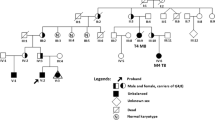Abstract
Background
The prevalence of chromosomal translocations is 1/500 in the general population. While in the vast majority of cases, carriers have a normal phenotype; they can present with difficulty conceiving due to the presence of a proportion of unbalanced gametes as a consequence of abnormal chromosomal segregation during meiosis. Since complex translocations involve three or more chromosomes, meiotic segregation leads to a greater number of possible combinations which effectively complicate both their study and therapeutic care.
Case presentation
We report on the case of a male carrier of a complex homogeneous double Robertsonian translocation: 44, XY, der(13;14)(q10;q10),der(21;22)(q10;q10). We studied his meiotic segregation by FISH on spermatozoa from the initial sample, as well as following discontinuous gradient centrifugation and after incubation in an hypo-osmotic solution.
Conclusion
We report a method to study in a simple single-step manner the meiotic segregation of double Robertsonian translocations in spermatozoa. Further, our results suggest that reproductive prognosis of affected individuals may be markedly improved by HOST-based sperm selection (HBSS).





Similar content being viewed by others
References
McKinslay G, Sutherland C. Abnormalities and genetic counseling. 4th ed. USA, chapters 4 & 6: Oxford University Press; 2011.
Lamotte A, Martinez G, Devillard F, Hograindleur J-P, Satre V, Coutton C, et al. Is sperm FISH analysis still useful for Robertsonian translocations? Meiotic analysis for 23 patients and review of the literature. Basic Clin Androl. 2018;28:5.
Rouen A, Balet R, Dorna M, Hyon C, Pollet-Villard X, Chantot-Bastaraud S, et al. Discontinuous gradient centrifugation (DGC) decreases the proportion of chromosomally unbalanced spermatozoa in chromosomal rearrangement carriers. Hum Reprod. 2013;28:2003–9.
Rouen A, Carlier L, Heide S, Egloff M, Marzin P, Ader F, et al. Potential selection of genetically balanced spermatozoa based on the hypo-osmotic swelling test in chromosomal rearrangement carriers. Reprod BioMed Online. 2017;35:372–8.
Roux C, Tripogney C, Morel F, Joanne C, Fellmann F, Clavequin MC, et al. Segregation of chromosomes in sperm of Robertsonian translocation carriers. Cytogenet Genome Res. 2005;111:291–6.
Moradkhani K, Puechberty J, Bhatt S, Lespinasse J, Vago P, Lefort G, et al. Rare Robertsonian translocations and meiotic behaviour: sperm FISH analysis of t(13;15) and t(14;15) translocations: a case report. Hum Reprod. 2006;21:3193–8.
Loup V, Bernicot I, Janssens P, Hedon B, Hamamah S, Pellestor F, et al. Combined FISH and PRINS sperm analysis of complex chromosome rearrangement t(1;19;13): an approach facilitating PGD. Mol Hum Reprod. 2010;16:111–6.
Pellestor F, Puechberty J, Weise A, Lefort G, Anahory T, Liehr T, et al. Meiotic segregation of complex reciprocal translocations: direct analysis of the spermatozoa of a t(5;13;14) carrier. Fertil Steril. 2011;95:2433.e17–22.
Godo A, Blanco J, Vidal F, Parriego M, Boada M, Anton E. Sequential FISH allows the determination of the segregation outcome and the presence of numerical anomalies in spermatozoa from a t(1;8;2)(q42;p21;p15) carrier. J Assist Reprod Genet. 2013;30:1115–23.
Juchniuk de Vozzi MS, Santos SA, Pereira CS, Cuzzi JF, Laureano LA, Franco JG, et al. Meiotic segregation and interchromosomal effect in the sperm of a double translocation carrier: a case report. Mol Cytogenet. 2009;2:24.
Ferfouri F, Boitrelle F, Clement P, Molina Gomes D, Selva J, Vialard F. Sperm FISH analysis of a 44,X,der(Y),t(Y;15)(q12;q10)pat,rob(13;14)(q10;q10)mat complex chromosome rearrangement. Andrologia. 2014;46:576–82.
Burns JP, Koduru PR, Alonso ML, Chaganti RS. Analysis of meiotic segregation in a man heterozygous for two reciprocal translocations using the hamster in vitro penetration system. Am J Hum Genet. 1986;38:954–64.
Author information
Authors and Affiliations
Corresponding author
Ethics declarations
Conflict of interest
The authors declare that they have no conflict.
Additional information
Publisher’s note
Springer Nature remains neutral with regard to jurisdictional claims in published maps and institutional affiliations.
Rights and permissions
About this article
Cite this article
Pierron, L., Irrmann, A., de Chalus, A. et al. Double chromosomal translocation in an infertile man: one-step FISH meiotic segregation analysis and reproductive prognosis. J Assist Reprod Genet 36, 973–978 (2019). https://doi.org/10.1007/s10815-019-01430-z
Received:
Accepted:
Published:
Issue Date:
DOI: https://doi.org/10.1007/s10815-019-01430-z




